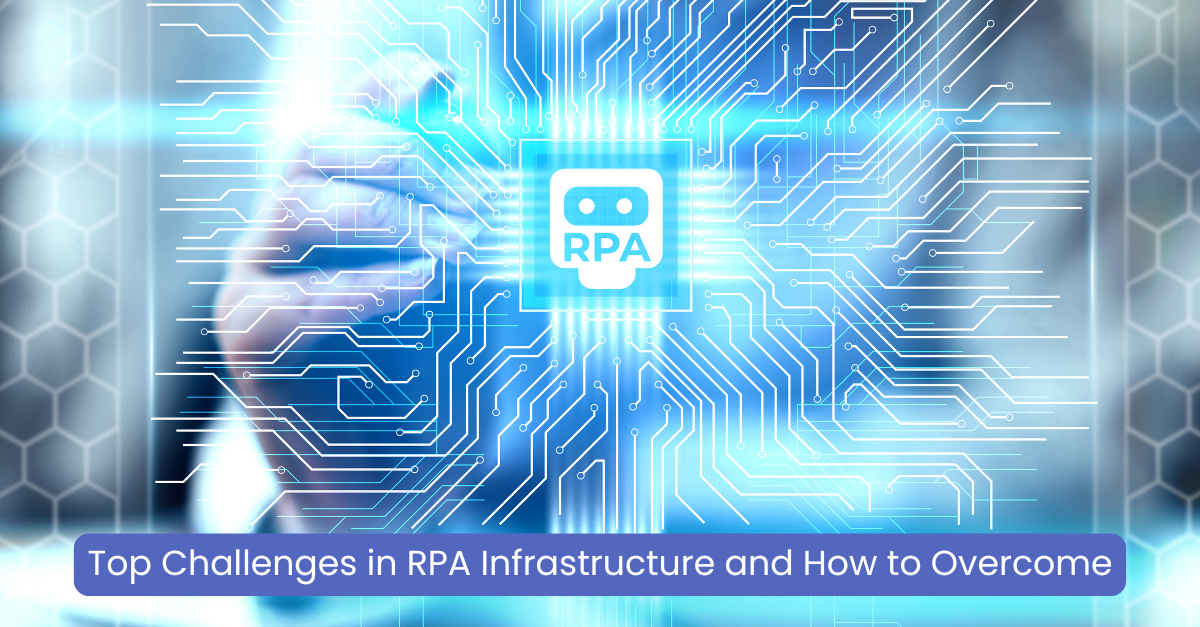Top challenges in RPA infrastructure and how to overcome them
Automation drives transformative changes across industries, with RPA infrastructure playing a key role in streamlining processes. Despite its potential, organizations face significant obstacles during implementation. Identifying and addressing these challenges is critical to realizing the full benefits of Robotic Process Automation (RPA). To overcome challenges in RPA infrastructure, organizations must focus on strategic solutions.
Table of Contents
Common challenges in RPA infrastructure
Integration with legacy systems
Many organizations rely on outdated systems that are incompatible with modern automation tools. This complicates automation in RPA infrastructure, leading to delays and operational inefficiencies.
Solution: Adopt middleware solutions to enable communication between old and new systems. Develop APIs to streamline data exchange and reduce compatibility issues. Implementing automation in RPA infrastructure is key to addressing these integration challenges.
Scalability Issues
Handling increasing workloads and adapting to changing demands can strain an RPA infrastructure not designed for growth, hindering effective automation.
Solution: Monitor system performance regularly and proactively expand infrastructure capacity. Ensure resource allocation matches workload demands to maintain efficiency. Ensuring scalability is critical in RPA infrastructure best practices.
Lack of skilled personnel
A shortage of personnel skilled in managing RPA infrastructure can slow implementation and impact automation efforts quality.
Solution: Invest in upskilling your workforce through regular training programs. Partner with experts to ensure seamless implementation and management of automation processes. Skilled personnel play a vital role in adhering to RPA infrastructure best practices.
High implementation costs
Some organizations are discouraged by the initial cost of deploying RPA infrastructure. Expenses related to software, hardware, and resources can seem overwhelming.
Solution: Start small by automating critical tasks. Evaluate potential returns to justify expenses and scale operations incrementally to manage costs effectively. Financial planning is a key part of managing challenges in RPA infrastructure.
Security Challenges in RPA Infrastructure
Data security risks
RPA deals with sensitive organizational data, making it a target for potential cyber threats. Weak security measures can expose vulnerabilities.
Solution: Implement multi-layered security protocols, including encryption and robust authentication. Regular security audits help ensure compliance with data protection standards. Enhancing security should be part of RPA’s overall role in IT infrastructure.
System Downtime
Automation tools rely on the stability of IT systems. Downtime or errors within the RPA infrastructure can significantly disrupt operations.
Solution: Conduct routine maintenance and testing of automation workflows. Use backup solutions to minimize disruption during unplanned outages. Addressing downtime can build resilience in RPA infrastructure.
Role of RPA in IT infrastructure optimization
RPA enhances IT infrastructure by automating repetitive processes, allowing IT teams to focus on strategic initiatives. However, integration with IT systems can face hurdles.
Solution: Facilitate collaboration between IT and RPA teams to align goals. Regular reviews ensure the RPA strategy complements broader IT objectives. The role of RPA in IT infrastructure is crucial to achieving a unified automation strategy.
Best practices for managing RPA infrastructure
Define clear goals
Ambiguity in objectives can lead to misaligned automation efforts. Organizations must define clear goals to optimize RPA infrastructure.
Solution: Create detailed process maps and prioritize tasks for automation. Maintain documentation to track progress and identify areas for improvement. Clear goals are vital for following RPA infrastructure best practices.
Automation in RPA Infrastructure and Its Challenges
Automation introduces complexities, including difficulty monitoring processes and handling unexpected system behaviors. These challenges in RPA infrastructure can hinder performance.
Solution: Employ analytics tools to monitor workflows in real-time. Use predictive algorithms to anticipate and address potential issues early. Automation in RPA infrastructure requires continuous monitoring to avoid disruptions.
Performance monitoring
Automation processes can deviate from expected outcomes without regular monitoring, causing inefficiencies in RPA infrastructure operations.
Solution: Implement continuous performance evaluation systems. Gather feedback from users and refine processes based on real-world outcomes. Monitoring performance is crucial in overcoming challenges in RPA infrastructure.
Building resilient RPA infrastructure
Scalability planning
Plan infrastructure to accommodate future growth. Anticipating challenges in RPA infrastructure ensures readiness for expansion without sacrificing efficiency.
Solution: Adopt cloud-based solutions for flexibility and capacity scaling. This approach enables you to adapt quickly to changing demands. Scalability is a fundamental consideration in building resilient RPA infrastructure.
Staff training and collaboration
Building a skilled workforce ensures a stronger RPA infrastructure. Collaboration across departments is also essential to achieve automation goals.
Solution: Provide hands-on training in automation tools. Promote collaboration between IT, business units, and RPA teams to align objectives effectively. Well-trained staff are essential for ensuring the role of RPA in IT infrastructure is executed successfully.
Adherence to best practices
Following RPA infrastructure best practices ensures smooth implementation and ongoing operations. Ignoring these principles can lead to inefficiencies and failures.
Solution: Develop a governance framework. Document lessons learned during implementation and encourage feedback loops for continuous improvement. Best practices form the foundation for long-term success in RPA infrastructure.
Security enhancements
Strengthening security across all layers of RPA infrastructure prevents data breaches and enhances trust in automated processes.
Solution: Deploy advanced security tools, including intrusion detection and threat intelligence platforms. Regular updates keep the system protected from evolving threats. Security should always be a priority in RPA infrastructure management.
Overcoming challenges with automation in RPA infrastructure
Addressing change resistance
Employees may resist adopting automation tools because they fear job displacement, which can delay the adoption of RPA infrastructure.
Solution: Educate employees about the benefits of RPA, emphasizing how it reduces repetitive tasks and allows them to focus on strategic work. Overcoming resistance is a critical step in ensuring the success of automation in RPA infrastructure.
Managing costs
High upfront costs can deter organizations from investing in RPA infrastructure. Careful planning helps mitigate these concerns.
Solution: Leverage open-source automation tools where possible. Conduct thorough ROI analysis to demonstrate long-term financial benefits. Cost management is essential for addressing challenges in RPA infrastructure.
Role of automation in resilience
Automation strengthens business resilience by enabling consistent operations, even during disruptions. Building an adaptive RPA infrastructure supports organizational goals.
Solution: Design workflows to ensure high availability. Backup automation processes and use failover systems to maintain continuity during unexpected events. RPA’s role in IT infrastructure ensures that systems remain resilient.
As businesses adopt automation at scale, RPA infrastructure will evolve to include advanced technologies like artificial intelligence and machine learning. These innovations will optimize processes further and expand automation capabilities.
Addressing integration, scalability, and security challenges today can help organizations lay the foundation for a resilient RPA infrastructure. Focusing on RPA infrastructure best practices and leveraging RPA’s role in IT infrastructure ensures sustainable success.
Ready to overcome challenges and build a resilient RPA infrastructure? Connect with Novas Arc to unlock AI and automation solutions tailored to your needs. Let’s enhance your processes for efficiency and growth!
FAQs
Key challenges include integration with legacy systems, scalability issues, high implementation costs, lack of skilled personnel, and data security risks.
RPA infrastructure refers to the foundational systems, tools, and frameworks that support the deployment, operation, and management of Robotic Process Automation.
The most critical factor is alignment with business goals, ensuring clear objectives, proper planning, and seamless integration with existing systems.
RPA failure occurs when automation processes do not deliver expected results due to issues like poor planning, technical errors, or inadequate monitoring and maintenance.








